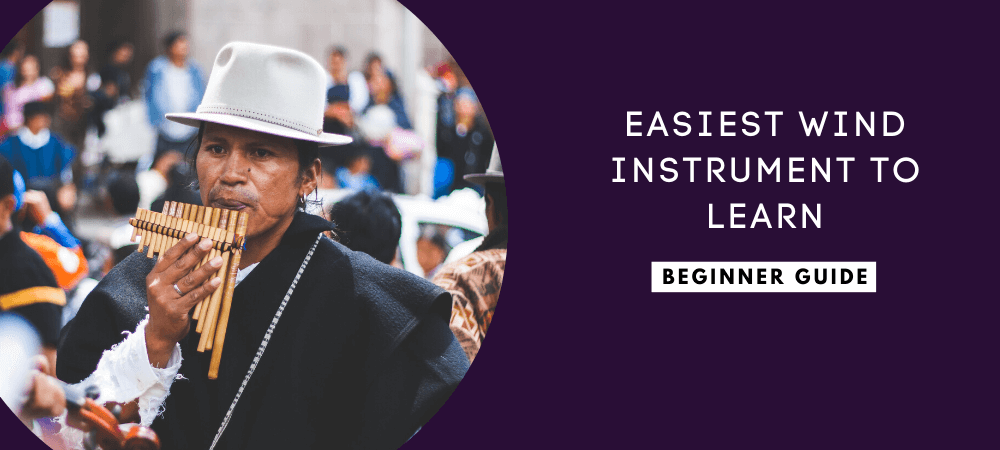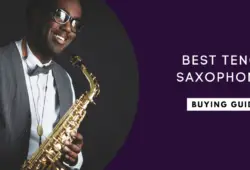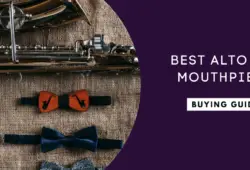Whoever said that music is food for the soul, was right.
I mean, there’s always a specific kind of good vibes that come with great music. Especially when combined with the use of a wind instrument.
So, if you’re done sitting at the backbench and would like to learn how to play any of the wind instruments, I understand you.
Everyone wants to be at the center of the thrill, right?
That said, it’s essential to know that some of these instruments are difficult to learn, while others are a bit easier, making them suitable for beginners.
Below is a list of the top 5 easiest wind instruments to learn. I hope it helps you to make an excellent choice.
Table of Contents
Easiest Wind Instrument to Learn
1. Recorder
If what you want is the cheapest wind instrument, which also turns out to be the easiest to play, then you can never go wrong with the recorder.
This wind instrument is light-weighted and easy to blow, making it an ideal choice for kids under the age of 10.
The fact that it’s also inexpensive makes it easier for parents, as they can purchase it for beginner classes before their children advance for a more complex tool.
The recorder’s fingerings share a great similarity to those of the Clarinet, so your little one can get around it with ease.
And with a combination of excellent music reading skills, time-management skills, and breathing exercises, one can learn the recorder within no time.
The history of this musical instrument goes back to the 14th century, where it was famously used in various entertainment events.
It, however, disappeared around the mid-18th century and is back now, with its presence being witnessed in various musical classes.
In fact, kids attending musical classes get to use a plastic one in their learning sessions.
2. Harmonica
This free reed wind instrument might not be as fashionable as the other instruments in this list, but the fact that it’s easy to play makes it hard to ignore.
Most individuals who have tried it will tell you how much fun it’s to play one.
Also, three primary things work in the harmonica’s favor. And that is its portability and ability to produce a relatively good sound, no matter how in-experienced the player is.
Plus, it’s pretty affordable.
Also, when you purchase a harmonica, it comes in a specific key.
For instance, a key C harmonica will make any C song sound good. And yes, you might not sound as great as an expert, but it won’t come out horribly.
The best part is that you can carry it in your pocket and get to practice whenever you want and at whatever time. This wind instrument is popularly used by blues and folk musicians.
3. Flute
Almost everyone knows or has heard about the flute. It’s one of the most commonly used wind instruments for beginners.
And because of that, it’s easy to learn.
You should, however, learn how to blow the sufficient amount of air it requires to produce the perfect sounds. Like the recorder, learners have to master the art of breath control.
This wind instrument is relatively light but is mostly recommended for older learners.
This is because some of the young learners (kids below the age of 10), find it challenging to hold horizontally. Plus, reaching some keys might be an uphill task for those small hands.
But, you can always get customized curved-head flutes, which are easy to manage even for beginners.
Also, did you know that the very first flute was made of wood? So, whenever you see the modern-day silver and metal-made flutes, know they have evolved over the years.
Plus, flutes can be played using two methods: end-blown or side-blown. So, the next time you want to try one out, you shouldn’t be surprised by any of this.
4. Clarinet
The Clarinet is another easy-to-learn wind instrument, which makes it beginner-friendly.
The term clarinet refers to the “little trumpet.” It usually uses a single-reed mouthpiece and comes in a cylindrical shape.
It’s the shape of this wind instrument that leads to the production of its distinctive musical sounds.
However, the quality of the sound produced by the Clarinet primarily depends on the player, the type of music involved, and the model of the instrument.
The type of reed and the mouthpiece also influence the sound.
For beginners, the instrument is easy to get by, but you will still have to learn a few complex details, such as the tone, dynamics, and correct tuning along the way.
You can easily play the two-octave range within no time, so long as you learn how to relax and control open inhalation and exhale appropriately.
To ensure you achieve great balance, get a clarinet that allows you to hold it with ease. For this, you can get one with a neck strap, thumb rests, lightweight bells, among other accessories.
5. Saxophone
You can’t speak about the Clarinet without thinking about or mentioning the Saxophone. These two wind instruments are closely related.
Most saxophones are made out of brass. And they are played using a mouthpiece, which is like that of the Clarinet.
Presently, there are nine types of saxophones, but the four most popular ones being used in the music industry are baritone, tenor, alto, and the soprano saxophones.
Out of the four, most beginners get comfortable around the tenor saxophone as opposed to the other three.
The alto saxophone, on the other hand, requires players to use a reed, similar to that of the Clarinet, and it has to be replaced often.
Since its invention by Adolphe Sax around the 1840s, this wind instrument has always been commonly used by classical musicians and jazz players.
Over the years, the Saxophone has advanced its features to be the dynamic and flexible wind instrument it’s today. So, once you learn to play it well, be ready to use in conveying many emotions and styles.
The best part of learning how to play the Saxophone lies in the fact that it will enhance your aural skills, language proficiency, and boosts your logical patterns identifying capabilities.
Things to Consider when Choosing a Wind Instrument
When choosing a wind instrument, you can count on the following useful tips. They will make the selection process manageable.
Age and Size of The Player
When it comes to choosing the perfect wind instrument, the size and the age of the player play a significant role.
For instance, for kids between the ages of 10-12, they are likely to find the flute and the Clarinet comfortable.
Kids under the age of 10 might find these two instruments a bit bulky, and because of that, they might not be able to sufficiently cover all the holes leading to the production of wrong sounds.
But, if your child is tall, and is under 10 years, then they can play either the flute or the Clarinet comfortably.
And that’s where the aspect of size comes in. For example, a child could be 11 years, but their short frame will not allow them to play the flute and thus end-up settling for the recorder.
The secret here lies in your ability to purchase a wind instrument that perfectly fits the player’s hands. If a learner can comfortably hold the instrument, then it will be easy and fun to learn.
A large instrument gives an uncomfortable hold, thus frustrating the learners’ efforts. And that’s the last thing they need for their first musical classes.
Presence of the Front Teeth
The front teeth are a significant part of a woodwind instrument.
Therefore, as you shop around, ensure they’re intact as they help to secure your instrument’s embouchure in perfect position.
It doesn’t matter if you see braces or not, because they won’t give you a perfect play just as the front teeth would.
If, by any chance, you get the opportunity to play a woodwind instrument with missing front teeth, you are likely to experience some pain as you play.
And yes, as some would argue, an orthodontic wax might help relieve the pain. But why would you want to invest in an instrument that won’t be fun to play?
Concentration Level
Before you invest in any wind instrument, it’s essential to consider its concentration level.
For beginners, you would want to pick an instrument that isn’t too demanding, as this can cause the learners to lose interest pretty first.
So, it’s advisable to choose an instrument that requires learners to concentrate for around 10-20 minutes. This is especially important when dealing with kids as their minds tend to be all over the place.
The shorter concentration time frame will allow them to focus on playing and enjoy learning various aspects purely.
And it’s for this reason that the recorder, flute, and Clarinet are on top when it comes to beginner wind instruments music classes.
So, you can also begin with them before progressing to the bassoon or oboe when you learn the robes and graduate to advanced levels.
The less complex the instrument is, the less the concentration level, and the better it’s for a learner.
Brand
If you thought that all wind instruments are the same, then you’ve been wrong all your life.
Yes, the instrument might serve the same purpose, but the quality of sound they produce, durability, and other extras, depending on the brand you settle for.
So, if you’re just beginning your musical journey and want a solid foundation that would lead to a profitable musical career, then you need to start right.
And that includes investing in a quality instrument that will serve you for a couple of years before you advance to professionalism.
The current marketplace is filled with thousands of brands. With each one of them claiming to be the best, it might be rough for you as a learner to know which brand to settle for.
But, you can never go wrong with renowned brands such as Buffet, Selmer, Emerson, Gemeinhardt, Yamaha, among others. So, do your research and invest well.
And this doesn’t mean you have to spend much, most of these companies have moderately priced instruments for beginners. Settle for one.
Mouthpiece
This is a significant part when it comes to selecting clarinets and saxophones because they require a mouthpiece.
And most of the time, these mouthpieces come with more options than even the instrument itself.
For a beginner, it’s advisable to settle for an instrument that comes with a mouthpiece. That way, you can use it to develop your tone before upgrading it.
And yes, the quality of the mouthpiece might not be top-notch, but it should serve its purpose well for a learner.
However, if your wind instrument doesn’t come with a mouthpiece, you have no choice but to purchase it separately.
And for a start, consider buying from known brands such as Vandoren, Yamaha, among others.
Yes, there are various good little-known brands out there, but it might be difficult for you to identify them straight away.
So, it’s best if you leave them for later when you’ve learned the ins and outs of the industry.
Also, a hard rubber mouthpiece is better than a plastic one, as it will significantly improve the tone produced.
Pro tip; always go for the medium-sized option.
Budget
The basic expenditure management rule is that: you should always have a budget in mind before you go shopping.
This way, you’ll avoid spending way above your budget, and it will narrow down your choices, thus making the process quicker.
For a beginner, start on a low or medium range budget. You can upgrade once you learn the instrument and are sure about the career path you want to take.
For instance, is it for fun or professional?
There’s no reason to waste a lot of money purchasing an instrument that you will only play for a couple of months and then lose interest.
But for individuals who are sure about their future in the wind instruments’ sector, investing in an expensive instrument shouldn’t be a problem.
Sometimes, it’s better to invest heavily once, than cheaply, which will mean replacing the instrument annually or so, which will be expensive in the long-term. It shouldn’t be a rush decision.
Skill Level
When it comes to the skill level of the player, there are numerous variables you should consider before investing in a wind instrument.
For instance:
- Do you have prior music theory knowledge?
- Does the player possess any experience with wind instruments?
- Does the player possess any fingering experience with any instrument?
Your answer to these questions will determine which instrument you get.
If you have been playing trumpet for years, then you will find it harder in your first alto saxophone class as opposed to a learner who has been playing the Clarinet.
Most of the time, when you want to try out advanced equipment, you should know which one closely relates to the one you have been playing.
And this is in terms of size, fingering, shape, among other attributes.
FAQs About The Easiest Wind Instrument to Learn
What Is the Most Popular Wind Instrument?
The Saxophone is the most popular wind instrument, and because of this, it’s primarily used by school orchestras.
The most prominent types of Saxophones are the tenor and alto, because they’re easy to play, especially for young learners.
But, you can also find the contrabass, soprano, among others.
They vary in shapes and sizes. And are famously used in jazz bands.
Where to Try Musical Instruments?
The best place to try out a musical instrument is at you’re the musical store around your area. Most stores allow you to try them out before settling for one.
You can also try some varieties in your musical class and various musical workshops within and outside your location.
Which Is the Hardest Wind Instrument to Play?
Most individuals say that the bassoon or the oboe is the hardest wind instrument. This is because they’re complex to tune.
In fact, any double-reed wind instrument won’t be easy to play. You simply have to be patient and slowly learn how to get around the tricky reeds.
Conclusion
The wind instruments family comprises of various instruments: of all sizes and shapes.
And while some are easy to play, some are not.
Therefore, as a learner, it’s essential to know which instruments are the easiest to learn so that you can invest appropriately.
The above list might not be conclusive, but it’s a good start, especially if you’re totally green about such matters.
We sure hope it helps you make the perfect choice according to your needs.


![How to Learn Saxophone by Yourself? [Beginner Guide]](https://musictechhub.com/wp-content/uploads/2020/04/How-to-Learn-Saxophone-by-Yourself-250x170.png)

